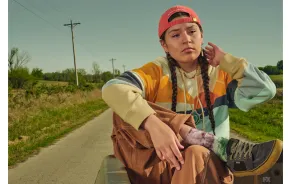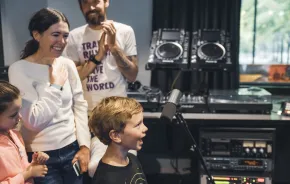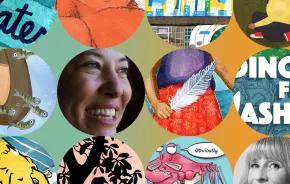
Last month, I went with my 10-year-old daughter to see Girl Rising, a film about nine girls around the world and the role education plays in lifting them out of poverty.
Before we went to see the film, I wanted my girl to be prepared to learn about some serious and uncomfortable topics covered in the film. We had a frank discussion about child marriage, rape, and slavery (although no graphic images are shown). Common Sense Media, which reviews movies and their suitability for kids, indicated this film was appropriate for age 12 and older.
However, as a parent, you are the one who knows your child best and can decide whether she or he (yes, boys should see this — males are an important part of the equation) can handle the sensitive nature of the topics.
My daughter is a voracious reader and can process stuff beyond her years, so I felt she was ready to move beyond the “safety” of books to a visual depiction of what’s happening in the world.
This film gives visual corroboration to knowledge we already have: Educating women and girls has the most optimistic, positive effects on families, communities and economies worldwide. If to see it is to know it, this film delivers hope; reasonable, measurable, tangible hope that the world can be healed and helped to a better future!
After we saw the film, my daughter and I spent a rare couple hours together just chatting about it. I wanted to hear how she had processed it, and I took notes of our conversation.
Me (M): That was quite a movie!
Daughter (D): I really like how it was presented. It was really creative.
M: Tell me more.
D: Words didn’t just appear on the screen. Instead, the girls held up signs with words to help tell the story. [The signs were mostly statistics about the status of girls worldwide].
I especially liked the cartoon about Yasmin, the girl from Egypt. She transformed herself into a superhero and spared the evil guy’s life. A true hero doesn’t kill, so that’s why she spared him.
M: That’s a great point. Yasmin’s story about superheroes was a coping mechanism that she used to suppress her memories of the rape.
D: Girls use their imagination when they are in difficult situations like Yasmin’s or to dream about what they would do if they weren’t poor. They all have dreams of having a better life.
M: Yes, just like Ruksana, the girl from India who got in trouble for drawing at school. Instead of getting angry or punishing her, Ruksana’s father bought her some new art materials. Why do you think he did that?
D: He was kind and wanted to do something good for her, which is better than punishing her. He told her, “You know how hard I struggle to send you to school so that you can study and make something of yourself?” Now she could focus on school but still draw and imagine a world coming alive in her free time.
M: Her father knew how important her art was to keep her imagination alive and that it would empower her to seek a better life and keep her spirits up.
D: Yeah, she was amazing — she was living on the streets with her family and they were so poor and had no food. At the end of the story she said, “At least me and my family are together and everything will be OK.” And I feel the same, that no matter what, you can be happy if you and your family are together.
M: How was Mariama, the girl from Sierra Leone, different from the others?
D: Mariama was the only one who was rich. She had an ipod and cell phone and listened to Rihanna! Hosting the radio show was inspiring to her and made her want to help other girls who were less fortunate.
M: But then she had a problem.
D: Yes, her stepdad was a barrier to her continuing with the radio show. He wanted her to stop. So she talked to Hawa, her stepdad’s other wife, and Hawa really listened to her, she believed in her, and got the stepdad to put her back on the air.
M: That goes to show how important family support is, right?

D: Yeah. Suma, Wadley, and Amina had no support. [Suma, from Nepal, was a kamlari, a slave sent away by her parents from the home to work for others when she was 6; Wadley, from Haiti, could no longer go to school when the earthquake happened because it destroyed her mother’s economic livelihood and they could not afford the school fees; and Amina, from Afghanistan, was a child bride, marrying at the age of 11, and had no voice or say in her fate.]
M: Yes, that is true. However, Azmera, from Ethiopia, had a brother who supported her decision not to marry at age 13 and encouraged her to continue her education. And Senna from Peru — her father required her to go to school so she could eventually escape the mining community [the family lived 17,000 feet high in the Andes mountains].
D: Yeah, I liked how Senna’s name means “warrior” [the correct spelling is Xena, but her father did not know how to read nor write]. Her father told her, “Make a better person of yourself, Senna. Study."
M: An education helps keep girls from marrying too young and opens up a world of possibilities, like for Senna who uses poetry to bring words alive, or for Sokha, from Cambodia, who became a dancer or for Mariama who became a radio show host. Also, girls are emotionally and physically too young to be parents. Many of them die in childbirth because their bodies are not yet fully developed to handle the labor.
D: Suma was so brave to go through what she did as a kamlari [we see in the film that even as a very young child she worked incredibly long hours and was beaten by her owners]. I think I am most like her because I don’t give up even though it can be hard. She writes songs to make herself happy, and if I were in her place I would write books.
M: Was there anything that surprised you about the movie?
D: It surprised me how many girls there are in poverty. But it made me feel more powerful as a girl and that I can do amazing things and make a big change in the world.
What you can do:
- Arrange for a screening of Girl Rising in your local theater.
- Invest in girls: Donate to the 10x10 Fund for Girls Education.
- Educate yourself about education for girls worldwide and what is being done. Some sources: Half the Sky Movement, United Nations Girls Education Initiative, Room to Read, The Girl Effect.
 Elizabeth Ralston is a writer with a public health background. She writes about topics on philanthropy, including profiles of inspiring people and organizations on her blog, The Inspired Philanthropist . When she is not writing, she enjoys spending time in the great outdoors with her family. You can follow her on Twitter.
Elizabeth Ralston is a writer with a public health background. She writes about topics on philanthropy, including profiles of inspiring people and organizations on her blog, The Inspired Philanthropist . When she is not writing, she enjoys spending time in the great outdoors with her family. You can follow her on Twitter.









